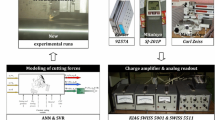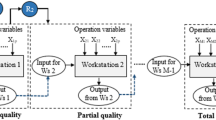Abstract
Understanding the variations in surface finish due to machining is a non-trivial task and cannot be very easily estimated even for a given set of machining parameters and operating conditions due to the complexity of interactions involved. In this work, an attempt has been made to propose an automated intelligent manufacturing system for the estimation and control of surface finish using support vector machines (SVM). SVM is very effective in mapping multi-dimensional parametric problems wherein standard analytical approaches become very complicated to handle. An intelligent surface finish control support system is built to provide assistance to the operator in a priori estimation of surface finish for a given selected set of feed rate, spindle speed and depth of cut. The estimated output can be compared by the operator with the required surface finish specification and if not satisfactory, alternate operating conditions can be defined. If found satisfactory, the operator can directly use these parameters and obtain the desired finish. Such an intelligent system will be a useful support to assist the machine operator in selecting optimum operating conditions to ensure the desired surface finish. The work carried out herein indicates that a lot of scope exists in the application of artificial intelligence techniques in mapping physical phenomena especially in the area of manufacturing wherein the inter-relationships are very complex and hence help build intelligent manufacturing support systems.
Similar content being viewed by others
References
Liu X, Soshi M, Sahasrabudhe A, Yamazaki K, Mori M (2006) A geometrical simulation system of ball end finish milling process and its application for the prediction of surface micro features. ASME J Manuf Sci Eng 128(1):74–85 doi:10.1115/1.2039098
Salisbury EJ, Domala KV, Moon KS, Miller MH, Sutherland JW (2001) A three-dimensional model for the surface texture in surface grinding, part 1: surface generation model. ASME J Manuf Sci Eng 123(4):576–581 doi:10.1115/1.1391427
Verma AK, Holcomb SL, Blessner P, Tilman D, Johnston WF (2003) Parametric study of surface finish in end milling using robust design techniques. In: ASME International Mechanical Engineering Congress, Washington, DC, November 15–21, 2003
Pavel R, Sinram K, Combs D, Pillar J, Marinescu I (2003) Surface finish for a case of continuous and interrupted OD hard turning. In: ASME International Mechanical Engineering Congress, Washington, DC, November 15–21, 2003
Gao T, Zhang W, Qiu K, Wan M (2006) Numerical simulation of machined surface topography and roughness in milling process. ASME J Manuf Sci Eng 128(1):96–103 doi:10.1115/1.2123047
Feng CX (2001) An experimental study of the impact of turning parameters on surface roughness. In: Proceedings of the 2001 Industrial Engineering Research Conference, Paper no. 2036, pp. 1–10
Lou MS, Chen JC, Li CM (1999) Surface roughness prediction techniques for CNC end milling. J Inf Technol 15(1):1–6
Wang X, Feng CX (2002) Development of empirical models for surface roughness prediction in finish turning. Int J Adv Manuf Technol 20(5):348–356 doi:10.1007/s001700200162
Sardinas RQ, Santana MR, Brindis EA (2006) Genetic algorithm-based multi-objective optimization of cutting parameters in turning processes. Eng Appl Artif Intell 19:127–133 doi:10.1016/j.engappai.2005.06.007
Fu S, Muralikrishnan B, Raja J (2003) Engineering surface analysis with different wavelet bases. ASME J Manuf Sci Eng 125(4):844–852 doi:10.1115/1.1616947
Liasi E, North WPT (2003) Surface finish enhancement in a turning operation via adaptive str control of the depth of cut. ASME J Manuf Sci Eng 125(2):289–296 doi:10.1115/1.1559155
Dugla Z (2003) Prediction of dimensional accuracy in CNC milling using computational intelligence technique. Ph.D. dissertation, Advanced Engineering and Manufacturing Laboratory, Department of Mechanical Engineering, Purdue School of Engineering and Technology
Ramesh R (2002) Measurement and modelling of machine tool thermal error under varying operating conditions. Ph.D. dissertation, Department of Mechanical Engineering, National University of Singapore
Kwok TJ (1998) Support vector mixture for classification and regression problems. In: Proceedings of the International Conference on Pattern Recognition (ICPR), Brisbane, Australia, pp. 255–258
Mukherjee S, Osuna E, Girosi F (1997) Nonlinear prediction of chaotic time series using support vector machines. In: VII Proceedings of the 1997 IEEE Workshop on Neural Networks for Signal Processing, pp. 511–520
Ramesh R, Mannan MA, Poo AN (2001) A comparison of support vector machines with artificial neural networks for the prediction of thermal errors in machine tools. Trans NAMRI/SME XXIX:577–584
Vapnik V, Golowich SE, and Smola A (1996) Support vector method for function approximation, regression estimation, and signal processing. In: Mozer MC, Jordan MI, and Petsche T (eds) Advances in neural information processing systems. Kaufmann, San Mateo, CA, pp 281–287
Gunn S (1998) Support vector machines for classification and regression. ISIS Technical Report, Image Speech and Intelligent Systems Group, University of Southampton
Haykin S (1999) Neural networks—a comprehensive foundation. Prentice Hall, New Jersey
Author information
Authors and Affiliations
Corresponding author
Rights and permissions
About this article
Cite this article
Ramesh, R., Ravi Kumar, K.S. & Anil, G. Automated intelligent manufacturing system for surface finish control in CNC milling using support vector machines. Int J Adv Manuf Technol 42, 1103–1117 (2009). https://doi.org/10.1007/s00170-008-1676-1
Received:
Accepted:
Published:
Issue Date:
DOI: https://doi.org/10.1007/s00170-008-1676-1




